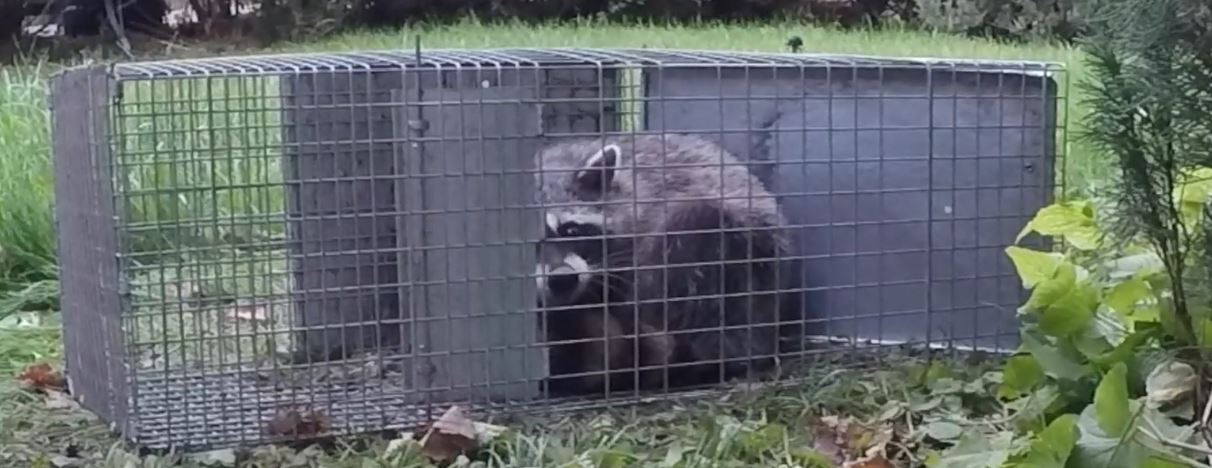Raccoon Trapping

Anyone who has ever had a raccoon on their property knows how much trouble they can cause, damaging your attic, knocking over your garbage, or simply eating your dog's food. Although there are several alternatives to trapping a troublemaking raccoon, some people will sometimes see this method as the best. Trapping allows you to relocate the raccoon to an area where it will cause less trouble or bring it to a wildlife sanctuary of some sort. If you are considering trapping a raccoon, you will need to know a few things first.
Trap Types
The majority of traps you can use on raccoons will have either one or two doors. One door traps make it easier for large adults to get fully inside the trap, reducing their risk of injury and entering partially only to escape. This type of trap also protects the bait better. Two door traps give raccoons two entry points, increasing your probability of catching one and will let you set them to have one or both doors open. Because you can see through these traps, it will sometimes calm raccoons, making them less prone to accidental injury while trying to escape.
Raccoon traps can also be divided into body grip, paw hold, and live cage traps. Live cage traps are the one or two door ones mentioned above. They typically are large metal cages where you place bait to attract the raccoon. Paw hold traps clamp down on the wild animal's paw and hold them in place, but it can be painful or harmful to the raccoon. As such, it is more common among trappers who then kill the animal and isn't typically recommended. Another type of trap to avoid is a body grip trap. They operate in a similar way to a mousetrap, with a spring that will clamp down and kill the raccoon. They are tricky and dangerous, both to the raccoon and other wildlife. Your best option is to always use a live cage trap or select a wildlife trapper who uses this method.
Bait To Use
Because raccoons will eat almost anything, you can theoretically use any item you want as bait. The best options, however, will be items that don't attract other wildlife, but will attract raccoons. Although they eat anything, they prefer items with a lot of sugar or fat. Some good ideas include crisp bacon, marshmallows, sweet corn, watermelon, fish, wet cat food, cooked fatty meat, and vegetables soaked in sugar or honey. Always remember to place your bait far enough back so that the raccoon has to fully enter the trap to reach it. For the best results, consider creating a trail of bait that guides the raccoon right to your trap.
In the case of mother raccoons with babies, there is also an alternative to using food items as bait. Mothers will do anything to reach their babies, even enter a trap. Keep in mind, however, that you need to wear thick gloves, move carefully, use a filter mask, and avoid the mother when entering areas such as your attic.
Trapping Methods
The general idea of trapping a raccoon is fairly straightforward. You select the trap, place it somewhere, put bait inside, and wait for the raccoon to enter. Placement is incredibly important, however, as you want to put it on an even surface so the raccoon won't become injured. You also want to put the trap by where the raccoon will be, such as close to its den, in your attic, or under your porch.
Checking The Trap
After you set your trap, you will need to check it very regularly, especially if it is exposed to direct sunlight. In the middle of the day, you should be checking the trap every hour or so, but at an absolute minimum, check it several times a day. Leaving a raccoon in the trap or an extended period of time can lead to it becoming very sick or dying due to heat exposure, starvation, or dehydration.
Check Legalities
Before you get ready to trap a raccoon that is bothering you, you will need to check the legalities of doing so in your area. Each state has their own laws and in most cases, you can't trap a raccoon. Sometimes you can only do so if you plan on killing it and disposing of it right away. In most cases, you will need special permission to relocate the raccoon. This means that if you are thinking of trapping a problem raccoon, you want to consult an expert first to make sure you are following the law.
Considerations
In addition to the legal concerns about trapping a raccoon, you also want to think about the general well-being of the animal. While relocating the wild animal may seem like an ideal situation, this is not the case. The raccoon will be unfamiliar with its new home, making it hard to find food, shelter, and water and may not know how to avoid predators in the area. Additionally, unless you get rid of the items that attracted the raccoon in the first place, a new one will simply take its place. That being said, sometimes trapping will be the best option, but that is not always the case.
Read the How to get rid of raccoons page for helpful information and to learn more about Raccoon Trapping

